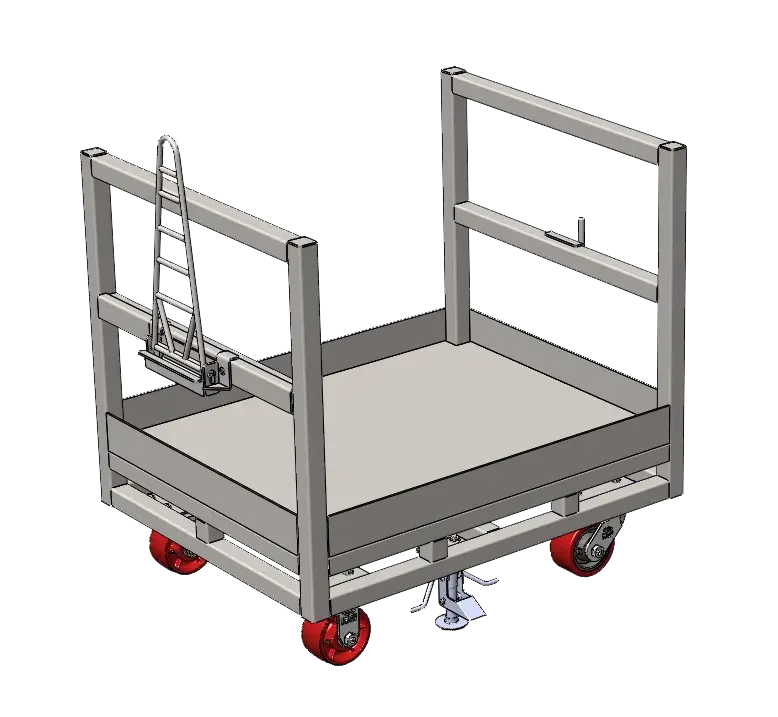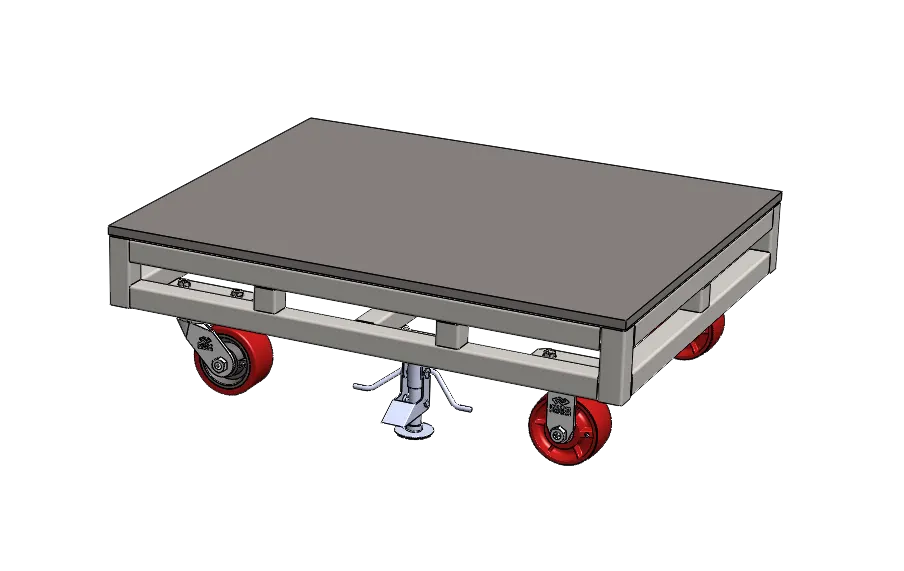Explore innovative designs, practical applications, and the numerous benefits of utilizing a wine barrel rack for your facility.
Read MoreHeavy Duty Material Handling Carts: Strength in Motion
What are Heavy Duty Material Handling Carts?
Heavy duty material handling carts are specialized equipment designed to transport heavy and bulky items within industrial and commercial environments. These carts are constructed with strong and durable materials such as steel or aluminum to withstand heavy loads and frequent use. Also, they are equipped with wheels or casters for easy maneuverability.
Using heavy duty material handling carts offers several benefits. Firstly, they allow for the efficient movement of materials, reducing the time and effort required to transport them manually. This helps to streamline workflow and increase overall productivity. Additionally, these carts promote workplace safety by reducing the risk of injury associated with lifting and carrying heavy objects.

Why are Heavy Duty Material Handling Carts Necessary?
The Role of Heavy Duty Material Handling Carts in Streamlining Workflow
These carts play a crucial role in streamlining workflow within various industries. These carts enable workers to efficiently move items, such as raw materials, finished products, or equipment, from one location to another. By providing a convenient and secure transportation method, they eliminate the need for manual lifting and carrying, which can be physically demanding and time-consuming.
How Heavy Duty Material Handling Carts Improve Efficiency and Safety
The use of these carts improves efficiency in the workplace in several ways. Firstly, they allow for the simultaneous movement of multiple items, saving time and effort. This enables workers to complete tasks more quickly and increases overall productivity. Moreover, these carts are designed with ergonomics in mind, ensuring that workers can easily maneuver them, reducing the risk of strain or injury.
In terms of safety, these carts significantly reduce the risk of workplace accidents. By eliminating the need for manual lifting and carrying, they minimize the chance of musculoskeletal injuries. Additionally, these carts often come equipped with safety features such as brakes or locking mechanisms, ensuring that items remain secure during transportation.
Cost and Time Savings with Heavy Duty Material Handling Carts
Investing in this type of cart can lead to significant cost and time savings for businesses. By utilizing these carts, companies can reduce labor costs associated with manual transportation, as fewer workers are needed to move items efficiently. Moreover, the streamlined workflow facilitated by these carts allows for faster completion of tasks, increasing overall productivity. This can result in cost savings by reducing the time required to complete projects or deliver products to customers.
Types of Heavy Duty Material Handling Carts
There are various types of these carts available, each designed to serve specific purposes. Some common types of carts include platform carts, utility carts, hand trucks, and flatbed carts.
Overview of Different Types of Heavy Duty Material Handling Carts
-
Platform carts: These carts have a flat platform surface to accommodate large and heavy items.
-
Utility carts: These carts have multiple shelves or compartments, allowing for the organized transport of smaller items.
-
Hand trucks: Hand trucks have a vertical frame with handles and a small platform for carrying items. They are ideal for moving heavy objects up and down stairs.
-
Flatbed carts: These carts have a large, flat platform with no sides or compartments. They are suitable for transporting oversized or irregularly shaped items.
Advantages and Applications of Each Type
-
1. Platform carts are versatile and can be used in various industries, including warehousing, manufacturing, and retail. They are particularly useful for transporting items such as boxes, crates, or machinery.
-
2. Utility carts are commonly used in office settings, hospitals, and schools. They are ideal for storing and moving supplies, files, or equipment.
-
3. Hand trucks are commonly used in delivery services and moving companies. They are essential for transporting heavy items such as appliances or furniture.
-
4. Flatbed carts are commonly used in construction sites, factories, or warehouses. They are designed to transport large and heavy items such as pallets or machinery.
Considerations when Choosing Heavy Duty Material Handling Carts
When selecting heavy duty material handling carts, there are several important factors to consider to ensure they are suitable for your specific needs. These factors include weight capacity and load suitability, maneuverability and ergonomics, durability and maintenance, and customization options.
Weight Capacity and Load Suitability
It is essential to choose carts that can safely accommodate the weight of the items you plan to transport. Exceeding the weight capacity of a cart can lead to accidents or damage to the cart. Additionally, consider the size and shape of the items to ensure they can be securely loaded onto the cart.
Maneuverability and Ergonomics
Consider the maneuverability and ergonomics of the carts, particularly if they will be used in tight spaces or challenging environments. Look for carts with swivel wheels or casters for easy maneuvering, and ergonomic handle designs for comfortable pushing or pulling.
Durability and Maintenance
Heavy duty material handling carts should be made from high-quality, durable materials to withstand heavy loads and frequent use. Consider carts with features such as reinforced frames, impact-resistant surfaces, or corrosion-resistant coatings. Additionally, ensure that routine maintenance and repairs are feasible, and replacement parts are readily available if needed.
Customization Options
Some carts offer customization options to meet specific requirements. These options may include adjustable shelves or platforms, removable sides or compartments, or the ability to attach additional accessories. Consider whether customization options are necessary based on the nature of the items being transported.

How do These Carts Work?
Heavy duty material handling carts are designed with specific components and features that enable their efficient operation. These components include wheels and casters, handles and grips, brakes and locking mechanisms, and adjustable height and configuration options.
Wheels and Casters
Wheels and casters are crucial components of these carts. They allow for smooth and efficient movement of the cart, even when transporting heavy loads. Ultimately, a company should look for carts with high-quality wheels or casters that are durable and offer excellent maneuverability.
Handles and Grips
Handles and grips on these carts allow for easy maneuvering and control. That being said, companies should look for carts with ergonomic handles that provide a comfortable grip and reduce strain on the user’s hands and wrists.
Brakes and Locking Mechanisms
Brakes and locking mechanisms are essential safety features on heavy duty material handling carts. These features ensure that the cart remains secure and stable during loading, unloading, or when stationary. Essentially, a company should look for carts with dependable braking systems and locking mechanisms that are easy to engage and disengage.
Adjustable Height and Configuration Options
Some carts offer adjustable height or configuration options to accommodate different loading and transportation needs. This flexibility allows for the transport of items of various sizes and shapes. Consider carts with adjustable platforms, shelves, or sides if you require versatility in your handling equipment.
Selecting the Right Heavy Duty Material Handling Carts for Your Needs
Selecting the appropriate carts for your specific needs requires consideration of several factors. These factors include size and dimensions, material compatibility, special features and accessories, and budget considerations.
Size and Dimensions
Consider the size and dimensions of the items you will be transporting. Choose carts with adequate platform, shelf, or compartment sizes to accommodate your specific requirements. Additionally, consider the overall dimensions of the carts to ensure they can fit through doorways or narrow spaces in your facility.
Material Compatibility
Different heavy duty material handling carts may be designed for specific materials or applications. Consider the compatibility of the carts with the materials you will be handling. For example, if you transport fragile or sensitive items, look for carts with cushioned surfaces or protective features to prevent damage.
Special Features and Accessories
Consider whether there are any special features or accessories that would enhance the usability and functionality of the carts for your specific needs. Examples of special features may include adjustable shelves, removable sides or compartments, or hooks for attaching additional tools or equipment.
Budget Considerations
Budget is an important consideration when selecting these carts. Determine your budget range and look for carts that offer good quality, durability, and functionality within that range. In essence, companies should consider the long-term cost savings that can be achieved through increased efficiency, reduced labor, and minimized maintenance needs.
How to Optimize the Use of Heavy Duty Material Handling Carts
Optimizing the use of these carts can further improve efficiency and safety in the workplace. Here are some tips to help you maximize their benefits:
1. Efficiently Organize and Load Carts
To maximize cart capacity and space utilization, organize items in a logical and secure manner. Use appropriate containers, dividers, or straps to prevent items from shifting during transportation. Consider weight distribution to maintain stability and prevent overloading.
2. Ensure Proper Handling Techniques
Proper handling techniques are crucial to ensure the safety of both the operators and the items being transported. Provide training on safe pushing, pulling, and maneuvering techniques. Teach employees how to handle heavy loads or navigate uneven surfaces properly to avoid accidents or injuries.
3. Regular Maintenance and Inspections
Regular maintenance and inspections are essential to keep heavy duty material handling carts in optimal working condition. Create a maintenance schedule to ensure carts are cleaned, lubricated, and inspected for any signs of wear or damage. Promptly address any issues to prevent further damage or the need for costly repairs.
Utilizing Heavy Duty Material Handling Carts in Various Industries
These carts are widely used across various industries to optimize workflow and enhance efficiency. Here are a few examples of industries that benefit from the use of these carts:
1. Warehousing and Distribution
In warehouses and distribution centers, these heavy duty carts are essential for moving large quantities of goods efficiently. These carts enable workers to transport items from storage areas to shipping areas, increasing productivity and reducing the manual effort required.
2. Manufacturing and Production Facilities
Manufacturing and production facilities often deal with heavy machinery, raw materials, and finished products. Essentially, these carts make it easier to transport these items within the facility, ensuring smooth operations and minimizing the risk of damage or accidents.
3. Healthcare and Medical Settings
In healthcare facilities, these carts are used to transport medical supplies, equipment, and patient files. These carts ensure timely delivery of essential items, enhance organization, and reduce the risk of injuries associated with manually carrying heavy loads.
4. Retail and E-commerce Operations
Heavy duty material handling carts play a vital role in the retail and e-commerce sectors. They are used for restocking shelves, transporting inventory, and fulfilling orders in warehouses or distribution centers. These carts enable efficient movement of products, saving time and improving customer satisfaction.
Conclusion
In conclusion, heavy duty material handling carts are essential equipment for streamlining workflow and improving efficiency in various industries. These carts eliminate the need for manual lifting and carrying, reducing the risk of injury and allowing for the simultaneous movement of multiple items.
By investing in high-quality carts that meet your specific needs, you can optimize your operations, enhance workplace safety, and achieve significant cost and time savings. Remember to consider factors such as weight capacity, maneuverability, durability, and customization options when choosing carts.
Overall, heavy duty material handling carts are a valuable asset for businesses seeking to streamline their workflow and boost productivity.

Customize Your Own & Get a FREE Estimate!
Simply e-mail us at sales@plexformps.com with all your information
OR call us today & speak to one of our packaging professionals









